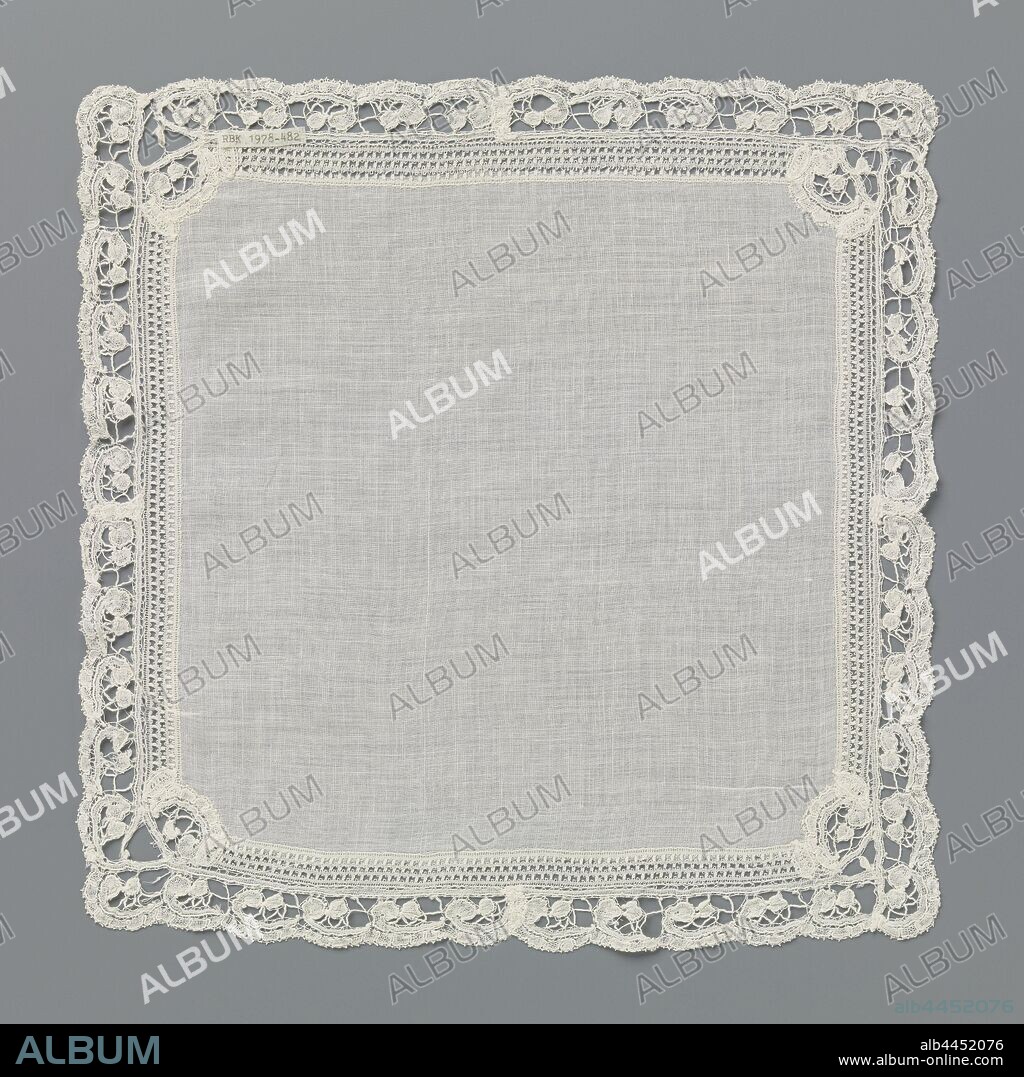alb4452076
Handkerchief of batist with double decorative frame with leather and j-shaped motifs, Handkerchief of natural-colored batist finished around with natural-colored bobbin lace: fine Bruges floral work. The bobbin lace consists of a double decorative frame along the edges of the handkerchief. The inner decorative frame consists of four extremely narrow lines that are connected to each other by square shapes. The decorative filling that makes up this list is also called 'leerkens' (ladders). Attached to this is the second, outer, decorative frame with a repeating pattern of one row of J-shaped curls with a dot above the curling end. The J-shaped motifs are connected to each other and to the inner decorative frame with a braided base. Outside they are connected to the faint scallop edge, which is formed by a concatenation of squares, alternately made in linen and net strokes, around which a thick contour thread winds. In every corner there is a J-shaped motif with ditto patches placed across the corner, but then the patches are directed inwards and touch the batist. The motifs are made in linen strokes and partly in net strokes (the squares) with openwork edges and thick contour lines. The scallop edge is finished with picots., anonymous, Bruges, c. 1890, cotton (textile), batiste, bobbin lace, l 30 cm × w 30 cm w 5 cm.

|
Ajouter à une autre Lightbox |
|
Ajouter à une autre Lightbox |



Avez-vous déjà un compte? S'identifier
Vous n'avez pas de compte ? S'inscrire
Acheter cette image

Légende:
Voir la traduction automatique
Handkerchief of batist with double decorative frame with leather and j-shaped motifs, Handkerchief of natural-colored batist finished around with natural-colored bobbin lace: fine Bruges floral work. The bobbin lace consists of a double decorative frame along the edges of the handkerchief. The inner decorative frame consists of four extremely narrow lines that are connected to each other by square shapes. The decorative filling that makes up this list is also called 'leerkens' (ladders). Attached to this is the second, outer, decorative frame with a repeating pattern of one row of J-shaped curls with a dot above the curling end. The J-shaped motifs are connected to each other and to the inner decorative frame with a braided base. Outside they are connected to the faint scallop edge, which is formed by a concatenation of squares, alternately made in linen and net strokes, around which a thick contour thread winds. In every corner there is a J-shaped motif with ditto patches placed across the corner, but then the patches are directed inwards and touch the batist. The motifs are made in linen strokes and partly in net strokes (the squares) with openwork edges and thick contour lines. The scallop edge is finished with picots., anonymous, Bruges, c. 1890, cotton (textile), batiste, bobbin lace, l 30 cm × w 30 cm w 5 cm
Personnalités:
Crédit:
Album / quintlox
Autorisations:
Modèle: Non - Propriété: Non
Questions sur les droits?
Questions sur les droits?
Taille de l'image:
6183 x 6183 px | 109.4 MB
Taille d'impression:
52.3 x 52.3 cm | 20.6 x 20.6 in (300 dpi)
Mots clés:
BATISTE • CINQ SENS: TOUCHER • CUIR • DEHORS • DESSIN D'ENCADREMENT • DISPUTE • EN PLEINE NATURE • FILE • MOUCHOIR • QUERELLE • SENS TACTIL • TISSU: COTON • TOUCHER • TOUCHER, CINQ SENS • VOILE (LINGE)
 Pinterest
Pinterest Twitter
Twitter Facebook
Facebook Copier le lien
Copier le lien Email
Email
